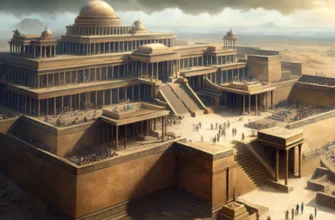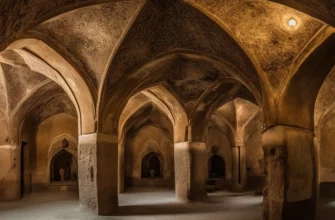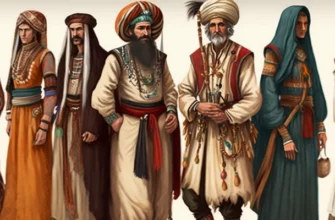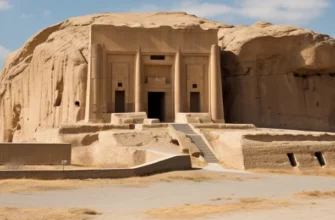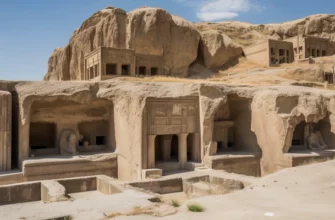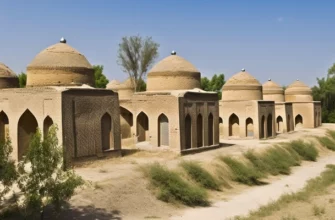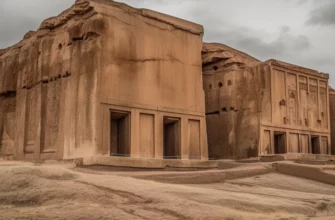Pasargadae is an ancient city in modern-day Iran, considered the first capital of the Achaemenid Empire. It was founded by Cyrus the Great in the 6th century BC. The city became not only a political center but also a symbol of the power of the Persian Empire. It was here that the foundations of state administration were laid, which later influenced other great empires of the ancient world.
The main architectural landmark of Pasargadae is the mausoleum of Cyrus the Great — a simple but monumental structure built of limestone, which has survived to this day. In addition to the mausoleum, the remains of the royal palace, gardens, canals, and defensive structures have been found in the city. The architecture of Pasargadae reflects both local traditions and influences from other cultures, demonstrating the empire’s openness to new ideas and styles.
Today, Pasargadae is of great historical and cultural significance. It is included in the UNESCO World Heritage List and is an important tourist and research site. This place continues to live in the national memory of Iran as a symbol of the greatness and heritage of one of the world’s oldest civilizations.
- The historical significance of Pasargadae
- Foundation of the city and its founder
- The role of Pasargadae in the formation of the Persian Empire
- Decline and disappearance of the city
- Architecture and cultural heritage
- Mausoleum of Cyrus the Great
- Structure and features of the mausoleum
- Historical disputes over the burial site
- The citadel and palace complex
- Architectural elements
- Archaeological research and preservation of the site
- Excavations and discoveries
- Inclusion in the UNESCO list
- Conclusion
The historical significance of Pasargadae
The historical significance of Pasargadae lies primarily in the fact that it was the first capital of the Achaemenid Empire, one of the most powerful states of the ancient world.
Founded by Cyrus the Great in the 6th century BC, it became the center of a political system that eventually covered vast territories from India to the Mediterranean Sea. In Pasargadae, Cyrus embodied the ideas of state governance, religious tolerance, and multiculturalism that became characteristic of the entire empire.
The city also has great symbolic significance as the burial place of Cyrus the Great. His mausoleum became not only an architectural masterpiece but also a sacred place for many generations. Pasargadae laid the foundation for palace architecture, which later developed in Persepolis. In addition, the city is an important source for studying Persian culture, administration, military strategy, and intercultural relations during the Achaemenid era.
Foundation of the city and its founder
Pasargadae was founded in the 6th century BC by Cyrus II, better known as Cyrus the Great, the founder of the Achaemenid Empire. It was he who united the Persian and Median tribes, creating the first multinational empire in history. After defeating the Medes around 550 BC, Cyrus chose a location for his new capital in the fertile valley of Pars (modern-day southern Iran), where the construction of Pasargadae began.
The city was not only an administrative and political center, but also the embodiment of the new imperial ideology. Its layout and architecture reflected the greatness of the ruler and the power of the state. Cyrus the Great personally supervised the construction, wanting to create a city that would become a symbol of unity, stability, and prosperity. After Cyrus’ death in about 530 BC, he was buried in a mausoleum, which is still considered one of Iran’s main historical monuments.
The role of Pasargadae in the formation of the Persian Empire
Pasargadae played a key role in the formation and consolidation of the Persian (Achaemenid) Empire. As the first capital of the newly formed state, the city became the political, administrative, and symbolic center of Cyrus the Great’s power. It was here that the foundations of imperial rule were laid, combining centralization of power with respect for local cultures and religions, which was innovative for that time.
A system of government was formed in Pasargadae that ensured the effective management of the empire’s vast territories. It was home to royal palaces, military bases, and religious buildings that reflected the grandeur and legitimacy of the Achaemenid dynasty. The city’s architecture, combining elements of different cultures — Mesopotamian, Elamite, Anatolian, and Iranian — embodied the idea of imperial unity.
Pasargadae also became a model for later Persian cities, especially Persepolis, and had great ideological significance. It was here that the foundations were laid for a model of statehood that lasted for over two centuries and influenced future empires in the East and West.
Decline and disappearance of the city
The decline of Pasargadae began after the death of Cyrus the Great and the transfer of the capital of the empire to the newly built Persepolis during the reign of Darius I. Although the city remained an important religious and cultural center for some time, its political and strategic importance gradually declined. With the loss of its status as capital, the rulers paid less attention to the development of Pasargadae, which contributed to its gradual decline.
The final blow to the city was dealt during the conquests of Alexander the Great in the 4th century BC. Although Alexander, according to ancient authors, visited the tomb of Cyrus and ordered its restoration, the city was already in a state of decline. Over time, Pasargadae lost its population and fell into ruin.
In the following centuries, the city disappeared from the political map of the region, and its remains were covered with sand. Only in modern times have archaeologists begun to explore the ruins, returning Pasargadae to the map of world historical heritage.
Architecture and cultural heritage
The architecture of Pasargadae is a striking example of the fusion of different cultural traditions, incorporating elements of Mesopotamian, Elamite, Anatolian, and local Iranian architecture. The city was built according to the plan of Cyrus the Great as a magnificent capital symbolizing the power, wisdom, and openness of the empire.
The most famous structure in Pasargadae is the mausoleum of Cyrus the Great, a massive but concise tomb built from large limestone blocks. It has the shape of a rectangular sarcophagus placed on a seven-step pedestal. This architectural masterpiece combines simplicity of design with monumentality, embodying the contemporary world’s ideas of royal dignity and eternity.
The remains of royal palaces with colonnades decorated with reliefs depicting the figures of the king, courtiers, and guards have also been preserved in the city. Of particular interest are the remains of gardens, considered to be among the first examples of Persian gardens — the so-called “chahar baghs” — with a clear symmetrical layout and irrigation system.
The cultural heritage of Pasargadae lies not only in its architectural structures, but also in the symbolic significance of the city. It became a source of inspiration for the further development of the Achaemenid imperial style, a model of the integration of many cultures into a single architectural language. Today, Pasargadae is listed as a UNESCO World Heritage Site, highlighting its exceptional value to humanity as the center of ancient Persian civilization.
Mausoleum of Cyrus the Great
The Mausoleum of Cyrus the Great is one of the most famous and important structures of ancient Iran, located in Pasargadae. It is the burial place of Cyrus II, the founder of the Achaemenid Empire, who united the Persian and Median peoples and established one of the largest empires of the ancient world.
The tomb is distinguished by its monumental simplicity and architectural symbolism. It consists of a rectangular burial chamber placed on a high six-step pedestal built of massive limestone blocks. The roof has the shape of a gabled pediment, reminiscent of a simple house or temple. The total height of the mausoleum is about 11 meters. The structure is impressive for its stability and has withstood more than two and a half thousand years of exposure to time and nature.
The architecture of the mausoleum combines elements of different cultures: Mesopotamian monumentality, Elamite simplicity, and Iranian symbolism. Unlike the lavish tombs of other rulers, Cyrus’ mausoleum is modest, reflecting his reputation as a wise and just king.
According to ancient historians such as Arrian and Strabo, Alexander the Great visited Cyrus’ mausoleum after conquering Persia and ordered it to be restored and protected, recognizing Cyrus’ importance as a great ruler.
Today, the mausoleum is not only an archaeological monument but also an important national symbol of Iran. It is listed as a UNESCO World Heritage Site and is honored as a cultural heritage that reflects the greatness and wisdom of one of the most outstanding rulers of the ancient world.
Structure and features of the mausoleum
The structure of the mausoleum of Cyrus the Great is an impressive example of ancient Iranian monumental architecture, combining simplicity, geometric precision, and symbolism.
The mausoleum has two main parts: a stepped base and a burial chamber.
The base consists of six wide limestone platforms that gradually narrow towards the top, forming a kind of pedestal about 5.5 meters high. Each step has a simple rectangular shape, and the entire structure looks massive and stable, as if emphasizing the immutability of royal power.
At the top of the pedestal is a small rectangular chamber — the tomb itself, with an entrance facing southeast. It is covered with a gabled roof resembling the roof of a traditional house, probably symbolizing the “house of eternity” for the deceased king. The chamber is made of large hewn blocks of white limestone, joined together without the use of cement. Inside, it is about 3.2 m long, 2.3 m wide, and up to 2.1 m high, which indicates its exceptional functionality and sacredness.
A distinctive feature of the mausoleum is its minimalism: unlike many royal tombs, it has no decorative carvings or inscriptions, which probably corresponds to the idea of modesty of Cyrus the Great. At the same time, the simplicity of the form gives the structure a sense of grandeur, and its harmonious proportions create a feeling of peace and strength.
Architecturally, the mausoleum combines elements from different cultures that were part of the empire: Elamite elevations, a Mesopotamian stepped base, and an Anatolian roof. This emphasizes Cyrus’ political idea of uniting different peoples under a single state.
Historical disputes over the burial site
Several historical disputes have arisen over the burial site of Cyrus the Great, concerning both the location of the mausoleum and the fact of his burial itself.
One of the main disputes concerns whether the mausoleum at Pasargadae is really the final resting place of Cyrus the Great. Ancient Greek sources, including the works of Arrian and Strabo, mention that Alexander the Great visited Cyrus’ mausoleum after conquering Persia and ordered its restoration. However, these sources do not always clearly indicate that this is his final resting place, and there are assumptions that Cyrus may have been buried elsewhere. For example, some scholars suggest that Cyrus the Great was buried in the city of Shusha (modern-day Iran), where there are also monuments linking this place to his name.
Another controversy concerns the appearance of the mausoleum itself. Some researchers believe that the tomb does not correspond to the traditions of the time and does not have the characteristic features of the large royal tombs that were common among the Achaemenid rulers. It looks modest compared to other tombs of rulers, such as those in Persepolis, which adds to the controversy surrounding its exact purpose.
There are also questions about possible reconstruction or changes that may have been made during the reign of later rulers. Although Alexander the Great ordered the mausoleum to be restored, not all researchers are convinced that this was merely a restoration and not a complete reconstruction or even a redesign of the tomb.
Despite these controversies, modern archaeology confirms that the mausoleum at Pasargadae is one of the main monuments linking Cyrus the Great to his legacy, and most historians agree that he was indeed buried at this site.
The citadel and palace complex
The citadel and palace complex of Pasargadae are important architectural elements that demonstrate the grandeur and complexity of the city’s organization, as well as the cultural and political aspects of Cyrus the Great’s reign. These structures served as administrative, religious, and symbolic centers, embodying the power and organizational skill of the Achaemenid Empire.
Citadel
The citadel at Pasargadae is located on a high hill and is the oldest fortification of its kind in Persia. Its strategic location allowed it to control the surrounding territories and perform defensive functions. The citadel had a complex system of walls that protected the city from attacks, as well as numerous passages and gates.
The structure was of great importance as a military base, as in conditions of constant war and struggle for power, it served as a place for gathering the army and storing weapons.
The structure of the citadel included fortified chambers that were part of the palace complex and also served as residences for senior officials. Thanks to numerous archaeological finds, it became known that the citadel was designed with a high level of engineering skill, which allowed it to perform not only defensive but also administrative functions.
Palace complex
The palace complex of Pasargadae, which was part of the royal residence, consisted of several magnificent buildings located on a large area. This complex symbolized the power of the king and emphasized the status of a state that united different peoples and cultures. Among the main elements of the palace were large open courtyards, luxurious reception halls, colonnades, and numerous rooms for solemn ceremonies.
The architectural elements of the palace reflected influences from different parts of the empire, testifying to the multicultural nature of the Persian state. For example, the use of large columns and massive stone blocks has features characteristic of Mesopotamian architecture, while the layout with wide courtyards and symmetrical colonnades has features characteristic of Iranian traditions.
The palace in Pasargadae is special because of its open spaces and how it used the natural landscape to create a sense of grandeur and connection with nature. We know that the palace had a really well-organized irrigation system to keep the gardens and green spaces looking good, which was important for Persian culture back then.
Significance of the citadel and palace
The citadel and palace complex of Pasargadae not only served as administrative and residential buildings, but also became a symbol of a new era in Persian history, when Cyrus the Great was able to unite different peoples under one rule. The city reflected the ideas of the Persian Empire, which sought stability, greatness, and cultural synthesis. These architectural monuments are important evidence of the development of Persian civilization and its influence on the surrounding world.
The remains of the palace complex and citadel today serve as archaeological evidence of the grandeur and perfection of ancient Iran, as well as embodying the symbolic legacy of Cyrus the Great and the Achaemenid Empire.
Architectural elements
The architectural elements of Pasargadae reflect the high skill and complexity of the architecture of that time, which combined the features of local traditions and the influences of other cultures that were part of the Achaemenid Empire. Here are some of the main architectural elements characteristic of Pasargadae:
- Stepped platforms (terraced bases)
One of the characteristic architectural elements of Pasargadae are the stepped platforms that form the base of many structures, including the mausoleum of Cyrus the Great. These platforms were built from large stone blocks and served not only to raise buildings but also had symbolic significance, indicating the greatness and immutability of royal power. The stepped structure also had practical significance: it protected buildings from possible flooding during floods and strengthened the structure.
- Columns and arches
Columns were an important element of Pasargadae architecture, particularly in palaces and administrative buildings. The columns were tall and slender and were often located in large halls or open spaces.
Their shape was similar to Mesopotamian models, but they also had features characteristic of Iranian architectural traditions. Palaces and royal residences often had large halls with rows of columns, which gave the interiors a monumental appearance.
Arches were also characteristic of Pasargadae architecture. They allowed for the construction of more spacious and taller rooms, which were important for palaces and large public buildings.
- Rectangular and square plans
Most buildings in Pasargadae, especially palaces, were rectangular or square in shape, which is characteristic of the architecture of ancient Iran and the Middle East. These geometric shapes were often used to create a clear organization of interior spaces, such as courtyards, halls, and rooms.
- High and strong walls
The buildings of Pasargadae are characterized by high and strong walls built of large limestone blocks. The walls were not only functional but also had symbolic meaning, emphasizing the empire’s steadfastness and stability. Architectural solutions, such as the use of limestone, allowed the buildings to withstand time and natural conditions.
- Irrigation systems and gardens
Pasargadae is known for its gardens, which are among the first examples of Persian gardens — “chahar baghs” — with a clear symmetrical structure and divided into four parts by water channels.
The architecture of Pasargadae included a complex irrigation system that allowed these gardens to be maintained, which became an important part of Persian culture and a symbol of wealth and prosperity.
- Mosaics and reliefs
The architecture of Pasargadae was also decorated with mosaics and reliefs, although these were less common than in later Persian capitals such as Persepolis. The reliefs on the walls often depicted the king, soldiers, officials, and animals, symbolizing the power and greatness of the ruler.
- Symmetry and organization of space
One of the main features of Pasargadae architecture was the clear organization of space and symmetry. Buildings and courtyards had harmonious proportions, emphasizing not only functionality but also visual grandeur. This is particularly evident in the layout of the palaces, gardens, and open spaces, where each element served in a specific way to emphasize the grandeur of the king and the empire.
- Natural materials
All the buildings of Pasargadae were constructed from local natural materials such as limestone, clay, and stone, which allowed the structures to be well preserved in the Iranian climate. The use of these materials also emphasized the connection between the architecture and the natural landscape.
Overall, the architectural elements of Pasargadae reflect not only functional needs but also an ideological component that demonstrates the grandeur, power, and stability of the Persian Empire during the reign of Cyrus the Great.
Archaeological research and preservation of the site
Archaeological research in Pasargadae began in the mid-19th century, when Western archaeologists first noticed the remains of this ancient city. However, serious archaeological work began here in the 20th century, and over the past few decades, the city has become an important site for studying the history and culture of ancient Iran.
The first excavations in Pasargadae were carried out in the 1930s and 1940s under the auspices of the Iranian archaeological service, when the mausoleum of Cyrus the Great and other important building complexes were discovered. After that, numerous international expeditions from Iran, France, Great Britain, and other countries continued to study the architectural remains of the city.
One of the most significant discoveries was the image of King Cyrus on one of the slabs in the architectural complex, which provided important evidence about the personality of this great ruler. Archaeologists also found reliefs depicting scenes from the life of Cyrus, as well as finds related to the administrative activities of Persian officials.
The excavations also helped to clarify the organization of the city itself: archaeologists discovered the remains of palaces, temples, administrative buildings, as well as parts of a large irrigation system that supported gardens and religious buildings.
Pasargadae is one of Iran’s most important archaeological and cultural sites and is protected by both the national and international community. In 2004, Pasargadae was added to the UNESCO World Heritage List, which helped draw more attention to the need to preserve this historical site.
The protection of Pasargadae includes a number of measures aimed at protecting the ruins from erosion, as well as from the effects of modern urbanization and human activity. Archaeologists and restorers are actively working in Iran to prevent further destruction of the city’s remains. Another important aspect of conservation is monitoring the condition of the mausoleum of Cyrus the Great, which is the most visited part of the complex. Recent restoration work has helped to stabilize and preserve the structure of the mausoleum.
Thanks to international support and active cooperation with UNESCO, Pasargadae has received additional resources for the preservation and promotion of this historical heritage. However, there are still challenges, particularly related to protection from natural disasters such as floods, as well as the need to protect against tourist crowds, which can damage sensitive archaeological sites.
Despite this, the protection of Pasargadae is an important priority for the Iranian government and international organizations working to preserve the cultural heritage of humanity.
Excavations and discoveries
Excavations and discoveries in Pasargadae, which are among the most important archaeological events in Iran, began in the mid-20th century and continue to this day.
Pasargadae, which became the capital of the Achaemenid Empire during the reign of Cyrus the Great, is impressive for its architectural heritage, and archaeological excavations have revealed numerous important finds.
The beginning of archaeological excavations
The first serious archaeological research of Pasargadae began in the 1930s and 1940s, when French archaeologists and Iranian scientists turned their attention to the ruins of this ancient city. However, the largest and most important excavations began after World War II, when Iranian archaeologists were actively working on the site.
The Mausoleum of Cyrus the Great
One of the most significant finds of archaeologists was the discovery of the mausoleum of Cyrus the Great. During the excavations, the remains of this magnificent building were found, which was built on six stepped platforms, allowing the site to be accurately identified as his burial place.
An important part of the discovery was also the study of the architectural elements of the mausoleum, which testify to the combination of different cultural traditions that existed in the empire.
Palace complexes and administrative buildings
The excavations also revealed numerous palace complexes and administrative buildings that were part of a large city. This allowed archaeologists to reconstruct the social structure of Pasargadae. In particular, huge halls used for state ceremonies and assemblies were discovered. However, many of the city’s buildings remain in ruins, and archaeologists have only begun to determine the structure and function of each structure.
Irrigation system and gardens
One of the important aspects of the excavations was the study of the irrigation system of Pasargadae, which allowed the famous Persian gardens to be maintained. It was discovered that the city was equipped with a complex network of canals to deliver water to the gardens and palaces. This supports historical accounts of Persian estates as symbols of power and prosperity that had great cultural and religious significance.
Reliefs and inscriptions
An important discovery was the numerous reliefs and inscriptions found on stone blocks. The inscriptions, written in cuneiform, helped researchers confirm the date of the city’s founding and identify key elements of Persian culture and politics at the time. In particular, one of the most important discoveries is a relief depicting Cyrus the Great as a king and warrior, reflecting his multifaceted image.
Underground tombs and burial structures
Researchers also discovered several underground tombs and burial structures, which are rare in ancient Iranian architecture. These tombs probably belonged to high-ranking individuals and may serve as evidence of a complex hierarchy in Pasargadae society.
Recent discoveries
In recent years, archaeological excavations have continued with the aim of uncovering even more details about the structure of the city and its inhabitants. Some new discoveries concern the identification of residential areas mixed with administrative functions, as well as the discovery of new parts of palaces and temple complexes.
The excavations have also allowed archaeologists to collect numerous artifacts, such as pottery, jewelry, and other household items, which provide unique insights into daily life in Pasargadae.
Archaeological excavations in Pasargadae are an important source of information about the culture, social organization, and political structure of ancient Persia.
They allow researchers to gain a deeper understanding of the legacy of the Achaemenid Empire and the role of Cyrus the Great in world history.
The excavations also make it possible to reconstruct the development of one of the world’s first empires, which left behind important cultural and architectural monuments that continue to inspire researchers today.
Inclusion in the UNESCO list
Pasargadae was added to the UNESCO World Heritage List in 2004, which was an important step in preserving and promoting this archaeological site internationally. The inclusion of Pasargadae on this prestigious list has drawn attention to the cultural significance of the city and its role in human history.
Reasons for the inclusion of Pasargadae in the UNESCO list
The main factors that led to the inclusion of Pasargadae in the World Heritage List are:
Historical significance: Pasargadae is the first capital of the Achaemenid Empire, founded by Cyrus the Great, which is of great importance for the history of Ancient Iran and world history. The city became the center of the political and cultural power of the Persians and a symbol of the formation of a vast empire that covered large territories.
Architectural heritage: The architectural complexes, including the mausoleum of Cyrus the Great, the palace complexes, the citadel, and the irrigation systems, are unique examples of ancient Persian architecture and engineering. Their design and technical execution influenced the development of architecture throughout the Middle East and Central Asia.
Cultural significance: Pasargadae embodies the richness of the culture, religion, and art of the Persian civilization, and the city is an important element in the development of Persian culture and art, particularly through its reliefs, inscriptions, and architectural features that demonstrate the achievements of the time.
Archaeological research: Thanks to archaeological excavations and discoveries, Pasargadae is revealing new pages in the history and culture of the Achaemenid Empire, providing unique information about the society, technology, and political structure of the time.
Significance for preservation and promotion
The inclusion of Pasargadae on the UNESCO World Heritage List has helped draw international attention to the importance of preserving this site. Thanks to this status, the city has received additional support for its efforts to protect and restore archaeological sites, and has become more accessible to tourists and researchers.
UNESCO also promotes programs aimed at preserving cultural heritage, providing financial support for restoration work, and raising awareness among the public and tourists about the importance of Pasargadae as part of world history. In addition, this inclusion highlights the global recognition of the significance of this historical site for all of humanity.
Thus, UNESCO World Heritage status helps to preserve Pasargadae as a treasure of human civilization and promotes international cooperation in the protection of cultural heritage.
Conclusion
Pasargadae, as the first capital of the Achaemenid Empire, is of great historical, cultural, and architectural significance.
The city became a symbol of Persia’s power and cultural flourishing during the reign of Cyrus the Great. Archaeological excavations, which continue to this day, have helped to restore the rich historical context of Pasargadae and demonstrated the importance of this site for world heritage. The inclusion of Pasargadae in the UNESCO World Heritage List in 2004 was an important step in the preservation of this unique monument and drew international attention to the need to protect cultural heritage.
Thanks to its architectural achievements, reliefs, inscriptions, and cultural significance, Pasargadae continues to be a subject of study and inspiration for scholars and tourists from around the world.
However, preserving this historical heritage requires ongoing efforts in conservation and restoration, taking into account modern challenges such as natural disasters and human activity.
In conclusion, Pasargadae is not only an important part of Iran’s history, but also part of the world’s cultural heritage, deserving of further attention and preservation.

